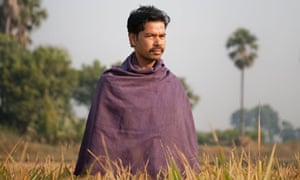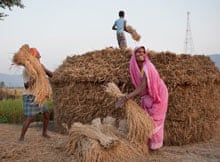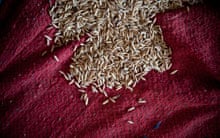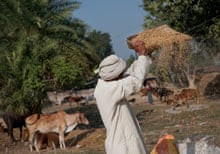Today in the U.S., about 16% of girls enter puberty by the age of 7, and about 30% by the age of 8. A recent
study determined that the number of girls entering puberty (defined by breast development) at these early ages has increased markedly between 1997 and 2010.
1
Trends in Age at MenarcheThe average age at menarche in Western countries began declining during the early part of the 20th century due to increased consumption of animal products and increasing calorie intake; the decline slowed in the 1960s, and now in the U.S. there has been a more recent surge in early puberty starting in the mid-1990s.
2 In Europe, in 1830, the average age at menarche was 17. Similarly in the 1980s in rural China, the average age at menarche was 17.
3 In the U.S. in 1900, the average was 14.2. By the 1920s, average age at menarche in the U.S. had fallen to 13.3 and by 2002, it had reached 12.34.
4 Similar trends are occurring in other Western nations.
5,6 For example, age at menarche in Ireland has declined from 13.52 in 1986 to 12.53 in 2006.
7 In Italy, a recent study showed that girls’ age at menarche was on average 3 months earlier than their mothers’.
8
Taking all this data together, we can estimate that the normal, healthy age at menarche under conditions of excellent nutrition without caloric excess, would probably fall somewhere between 15 and 18. But today in the U.S., about half of girls begin developing breasts before age 10, and the average age at menarche is less than 12 ½ and still declining.
Why is this happening?
The neurological and hormonal systems that regulate pubertal timing are complex, but research has identified a number of environmental factors that may be contributing to the decline in age at puberty:
- Increasing rates of childhood overweight and obesity
Several studies have found associations between higher childhood BMI and earlier puberty in girls.
4,9-11Excess body fat alters the levels of the hormones insulin, leptin, and estrogen, and these factors are believed to be responsible for the acceleration of pubertal timing by obesity. Also, physical inactivity may decrease melatonin levels, which can also affect signals in the brain that trigger pubertal development.
4,12
- Increased animal protein intake
Higher total protein, animal protein, and meat intake in children age 3-7 have been associated with earlier menarche in multiple studies.
13-15 In contrast, higher vegetable protein intake at age 5-6 is associated with later menarche.
15 High protein intake elevates IGF-1 levels and promotes growth, which could accelerate the onset of puberty – IGF-1 contributes to pubertal development on its own and in part by its involvement in estradiol signaling.
4,16 Meat and dairy consumption in children may also reflect ingestion of environmental endocrine-disrupting chemicals (EDCs) that have accumulated in animal tissues (see EDCs below).
High dairy consumption is associated with earlier than average menarche.
17 Soft drink consumption is associated with early menarche.
18
Children with
lower nutrient diets (based on analysis of macronutrients, vitamins, minerals, and certain whole foods) tend to enter puberty earlier.
19 Overall our modern diet rich in processed foods, dairy, processed meats and fast food is disruptive to normal development and aging. Early puberty is an early sign of premature aging.
- Exposure to endocrine-disrupting chemicals (EDCs)
EDCs are hormonally active synthetic chemicals that either mimic, inhibit, or alter the action of natural hormones. These chemicals are ubiquitous in our environment, and are considered by scientists to be a significant public health concern. Although EDCs are thought to pose a threat to adults as well, children’s bodies are more sensitive to exposure to exogenous hormones.
20 Chemicals are not currently tested for their endocrine disruption potential before they are approved for use and enter our environment, and there are endocrine disruptors in a vast array of products we come into contact with every day, including organochlorine pesticides, plastics, fuels, and other industrial chemicals.
21
The substances of most concern currently are BPA and phthalates.
BPA is one of the highest volume chemicals produced in the world. It is used in the manufacture of polycarbonate plastics, such as rigid cups, water bottles and food storage containers; BPA is also found in the linings of food cans and dental sealants. BPA can leach from containers into food and beverages, especially during heating and washing.
4 BPA exposure is associated with early puberty in girls.
22
Phthalates are chemicals used to make PVC plastics more flexible, and are found in a variety of products including toys, food packaging, hoses, raincoats, shower curtains, vinyl flooring, wall coverings, lubricants, adhesives, detergents, nail polish, hair spray, and shampoo. Phthalates are associated with early breast development in girls.
22,23 They are considered chemicals of concern to the EPA and may be phased out – some phthalates have already been removed from children’s toys and cosmetics.
24
Additional EDCs that have been associated with dysregulation of pubertal timing include industrial chemicals such as PCBs, pesticides such as DDT and endosulfan, the flame retardant PBB, and
dioxins and furans, which are formed during incineration of waste, chlorine bleaching of paper, and chemical manufacturing.
22,23,25,26
It is important to note that EDCs break down very slowly and accumulate in the fatty tissues of animals, so animal foods contain higher levels of these chemicals than plant foods.
Why is this troublesome?The most significant and alarming consequence of early maturation is an increased risk for breast cancer in adulthood. Early menarche is an established risk factor for breast cancer, and this is believed to be due to the extended lifetime exposure to ovarian hormones.
10,27,28 Similarly, exposure to EDCs during childhood is associated with hormonal cancers, such as breast and testicular cancers.
29-31
Seven, eight and nine year old girls are not emotionally or psychologically equipped to handle puberty. As such, earlier puberty is also associated with a higher risk of psychological problems during adolescence such as anxiety, depression, and eating disorders. Girls who mature earlier are also more likely to take part in risky behaviors like smoking and alcohol use.
4,12
What can parents do to protect their children?
- Children’s diets should focus on whole plant foods rather than animal foods – this will keep protein intake in a safe range and reduce their consumption of EDCs.
- Minimize dairy products in children’s diets – use almond and hemp milks instead of cows’ milk
- Encourage children to exercise and exercise with them.
- Minimize processed foods – these are calorie-dense and nutrient-poor, and they promote obesity and other diseases.
- Children’s diets should include as wide a variety of natural plant foods as possible including, green vegetables, squashes, corn, carrots, tomatoes, onions, mushrooms, nuts, seeds, avocados, beans, fruits and whole grains. This means that healthy eating is a lifetime event.
- Buy organic produce when possible to avoid synthetic pesticides.
- Minimize children’s exposure to BPA:
- Avoid use of rigid polycarbonate plastics (recycling label #7) whenever possible.
- Do not use plastic water bottles.
- Do not microwave in plastic containers.
- Minimize the use of canned foods and avoid canned infant formulas.32
- Minimize children’s exposure to phthalates
To conclude, the earlier occurrence of puberty is an ominous event that we can stop. We can even win the war on breast cancer in America and prevent millions of young females from developing it. The answer however, must begin in the way we feed ourselves and our children. The most effective type of health care is vigilant and excellent self care.
References:1. Biro FM, Galvez MP, Greenspan LC, et al: Pubertal Assessment Method and Baseline Characteristics in a Mixed Longitudinal Study of Girls.
Pediatrics 2010.
2. Biro FM, Khoury P, Morrison JA: Influence of obesity on timing of puberty.
Int J Androl 2006;29:272-277; discussion 286-290.
3. Gates JR, Parpia B, Campbell TC, et al: Association of dietary factors and selected plasma variables with sex hormone-binding globulin in rural Chinese women.
Am J Clin Nutr 1996;63:22-31.
4. Steingraber S: Tha Falling Age of Puberty in U.S. Girls: What We Know, What We Need To Know. In
Breast Cancer Fund; 2007.
5. McDowell MA, Brody DJ, Hughes JP: Has age at menarche changed? Results from the National Health and Nutrition Examination Survey (NHANES) 1999-2004.
J Adolesc Health 2007;40:227-231.
6. Anderson SE, Must A: Interpreting the continued decline in the average age at menarche: results from two nationally representative surveys of U.S. girls studied 10 years apart.
J Pediatr 2005;147:753-760.
7. O'Connell A, Gavin A, Kelly C, et al: The mean age at menarche of Irish girls in 2006.
Ir Med J 2009;102:76-79.
8. Rigon F, Bianchin L, Bernasconi S, et al: Update on age at menarche in Italy: toward the leveling off of the secular trend.
J Adolesc Health 2010;46:238-244.
9. Aksglaede L, Juul A, Olsen LW, et al: Age at puberty and the emerging obesity epidemic.
PloS one 2009;4:e8450.
10. Vandeloo MJ, Bruckers LM, Janssens JP: Effects of lifestyle on the onset of puberty as determinant for breast cancer.
Eur J Cancer Prev 2007;16:17-25.
11. Kaplowitz PB: Link between body fat and the timing of puberty.
Pediatrics 2008;121 Suppl 3:S208-217.
12. Burt Solorzano CM, McCartney CR: Obesity and the pubertal transition in girls and boys.
Reproduction 2010;140:399-410.
13. Berkey CS, Gardner JD, Frazier AL, et al: Relation of childhood diet and body size to menarche and adolescent growth in girls.
Am J Epidemiol 2000;152:446-452.
14. Rogers IS, Northstone K, Dunger DB, et al: Diet throughout childhood and age at menarche in a contemporary cohort of British girls.
Public Health Nutr 2010:1-12.
15. Gunther AL, Karaolis-Danckert N, Kroke A, et al: Dietary protein intake throughout childhood is associated with the timing of puberty.
J Nutr 2010;140:565-571.
16. Veldhuis JD, Roemmich JN, Richmond EJ, et al: Endocrine control of body composition in infancy, childhood, and puberty.
Endocr Rev 2005;26:114-146.
17. Wiley AS: Milk intake and total dairy consumption: associations with early menarche in NHANES 1999-2004.
PloS one2011;6:e14685.
18. Vandeloo MJ, Bruckers LM, Janssens JP: Effects of lifestyle on the onset of puberty as determinant for breast cancer.
Eur J Cancer Prev 2007;16:17-25.
19. Cheng G, Gerlach S, Libuda L, et al: Diet quality in childhood is prospectively associated with the timing of puberty but not with body composition at puberty onset.
J Nutr 2010;140:95-102.
20. Aksglaede L, Juul A, Leffers H, et al: The sensitivity of the child to sex steroids: possible impact of exogenous estrogens.
Hum Reprod Update 2006;12:341-349.
21. Diamanti-Kandarakis E, Bourguignon JP, Giudice LC, et al: Endocrine-disrupting chemicals: an Endocrine Society scientific statement.
Endocr Rev 2009;30:293-342.
22. Roy JR, Chakraborty S, Chakraborty TR: Estrogen-like endocrine disrupting chemicals affecting puberty in humans--a review.
Med Sci Monit 2009;15:RA137-145.
23. Den Hond E, Schoeters G: Endocrine disrupters and human puberty.
Int J Androl 2006;29:264-271; discussion 286-290.
24. Chemical Families: Phthalates. In
Environmental Working Group.
25. Schell LM, Gallo MV: Relationships of putative endocrine disruptors to human sexual maturation and thyroid activity in youth.
Physiol Behav 2010;99:246-253.
26. Massart F, Parrino R, Seppia P, et al: How do environmental estrogen disruptors induce precocious puberty?
Minerva Pediatr 2006;58:247-254.
27. Leung AW, Mak J, Cheung PS, et al: Evidence for a programming effect of early menarche on the rise of breast cancer incidence in Hong Kong.
Cancer Detect Prev 2008;32:156-161.
28. Pike MC, Pearce CL, Wu AH: Prevention of cancers of the breast, endometrium and ovary.
Oncogene 2004;23:6379-6391.
29. Cohn BA, Cirillo PM, Christianson RE: Prenatal DDT exposure and testicular cancer: a nested case-control study.
Arch Environ Occup Health 2010;65:127-134.
30. Cohn BA, Wolff MS, Cirillo PM, et al: DDT and breast cancer in young women: new data on the significance of age at exposure.
Environ Health Perspect 2007;115:1406-1414.
31. Maffini MV, Rubin BS, Sonnenschein C, et al: Endocrine disruptors and reproductive health: the case of bisphenol-A.
Mol Cell Endocrinol 2006;254-255:179-186.
32. Consumer tips to avoid BPA exposure. In
Environmental Working Group.




